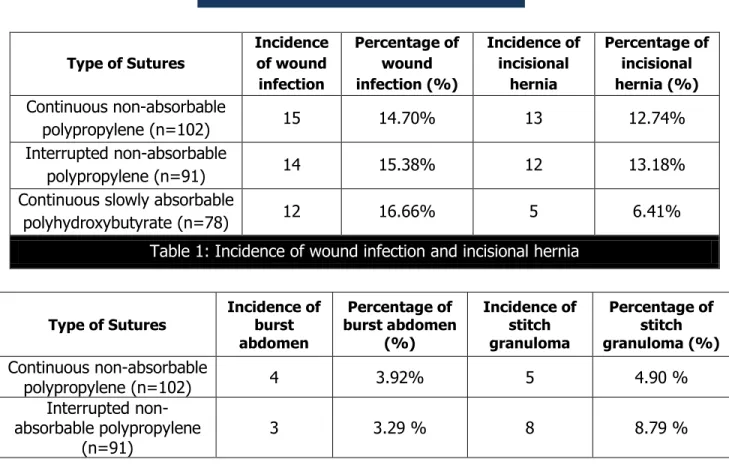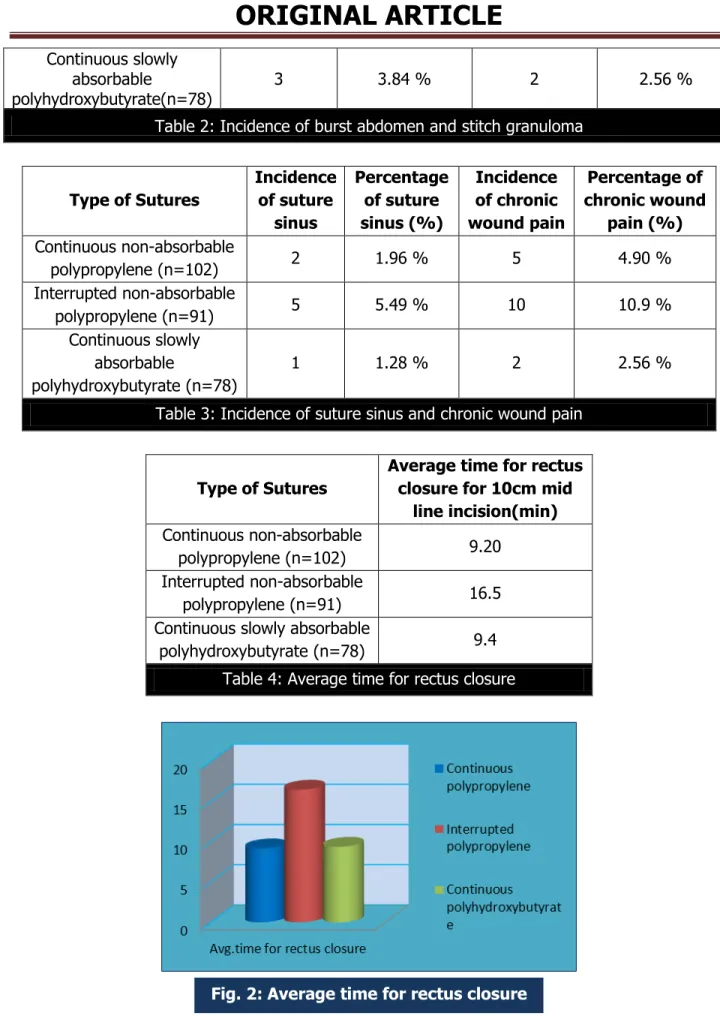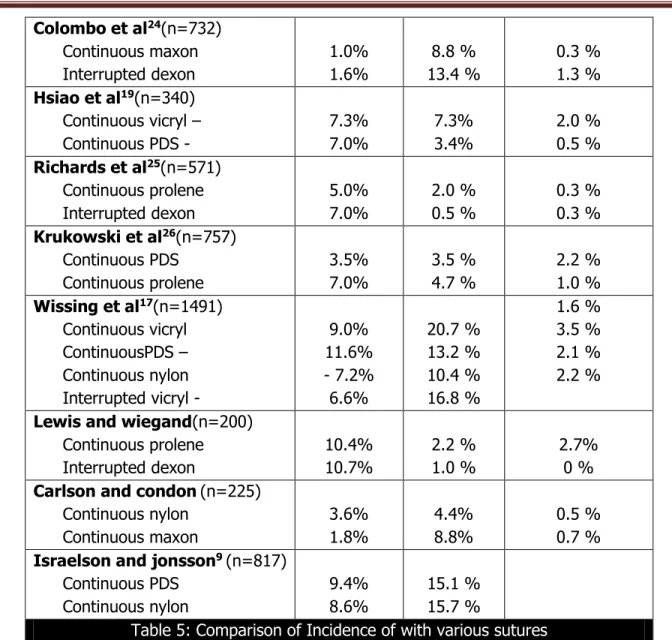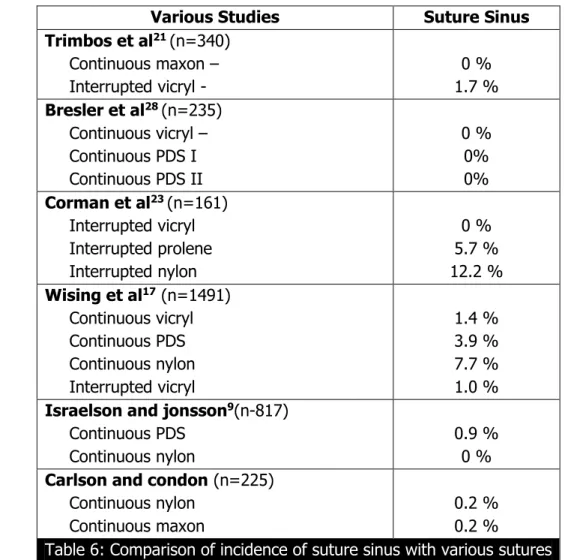COMPARISON OF ABSORBABLE EXTRA LONG TERM POLY HYDROXY
BUTYRATE SUTURE VS NON ABSORBABLE (POLYPROPYLENE)
SUTURE FOR ABDOMINAL WALL CLOSURE
P. Mallikarjun1, Vinay Sagar Cheeti2, Kiran Uske3HOW TO CITE THIS ARTICLE:
P. Mallikarjun, Vinay Sagar Cheeti, Kiran Uske. ”Comparison of Absorbable Extra Long Term Poly Hydroxy Butyrate Suture VS Non Absorbable (Polypropylene) Suture for Abdominal Wall Closure”. Journal of Evidence based Medicine and Healthcare; Volume 2, Issue 29, July 20, 2015; Page: 4215-4225,
DOI: 10.18410/jebmh/2015/598
ABSTRACT: PURPOSE: The aim of study is to compare Continuous technique with non- absorbable sutures, Interrupted technique with non-absorbable sutures and Continuous technique with slowly absorbable sutures Focusing mainly on incidence of incisional hernias, burst abdomen, wound infections, chronic wound pain, suture sinus, stitch granuloma, time for rectus closure.
METHODOLOGY: Study was conducted for a period of one year on 271 randomized patients with primary elective midline laparotomy in our hospital. patients are divided into group I includes 102 patients with continuous technique using non absorbable polypropylene, group II includes 91 patients with interrupted technique using non absorbable polypropylene and group III includes 78 patients with continuous slowly absorbable polyhydroxybutyrate. RESULTS: No significant difference observed in incidence of wound infections and burst abdomen in all the 3 groups but relatively higher incidence of wound infections in noted our hospital. Incidence of stich granuloma suture sinus and chronic wound pain is more with interrupted technique than continuous technique and are more with non-absorbable suture material. CONCLUSION: Incidence of incisional hernias, suture complications like suture sinus, stitch granuloma can be more effectively reduced with slowly absorbable continuous sutures.
KEYWORDS: Non-absorbable polypropylene, Absorbable polyhydroxybutyrate, Laparotomy.
INTRODUCTION: In patients undergoing midline incisions, rectus sheath can be closed with continuous or interrupted suture using absorbable or non-absorbable materials. Despite major improvements in antibiotics, better anesthesia, superior instruments, earlier diagnosis of surgical problems, and improved techniques for postoperative vigilance, post-operative complications like incisional hernias, burst abdomen, wound infections continue to occur, which causes significant surgical health care problem. The rate of incisional hernias 1 year postoperatively is estimated to be 9–20%,(1–4) the frequency of reoperation due to burst abdomen 1–3%(5–8) and the rate of wound infections 3–19%.(9–12) The optimal technique and suture material for abdominal wall closure have, therefore, long been a matter of debate.(13–19)
Decrease of the post-operative surgical complications can reduce the length of hospital stay, significant morbidity and even mortality and financial burden to the health care system.
closure, with negative results. But recently, studies in other countries showed that slowly absorbable suture materials can reduce the challenges of abdominal wall closure, which was least explored in our country.
The aim of study is to compare Continuous technique with non-absorbable sutures (polypropylene) in group I, Interrupted technique with non-absorbable suture (polypropylene) in group II Continuous technique with slowly absorbable sutures (polyhydroxybutyrate) in group III, of rectus sheath closure. Focusing mainly on incidence of incisional hernias, burst abdomen, wound infections, chronic wound pain, suture sinus, stitch granuloma, time for rectus closure.
METHODOLOGY: It is Randomized controlled, prospective study on 271 patients with primary elective midline laparotomy in our hospital. Patients operated from October 2013 to October 2014 are included in this study and are followed up for a minimum period of one year.
INCLUSION CRITERIA: Age in between 18-70 years Patients undergoing elective primary midline laparotomy, expected length of incision of at least 10 cms and Life expectancy more than one and half year.
EXCLUSION CRITERIA: Patients requiring emergency surgery, Patients undergoing immunosuppressive therapy, Patients undergoing chemotherapy within two weeks before surgery, Patients undergoing radiotherapy longer than 8 weeks before surgery, patients with coagulopathy.
Controls are considered of patients in whom the abdominal fascia closed with polypropylene are included in control group. Thus this study contains two control groups i.e. group I (Continuous polypropylene) and group II (Interrupted polypropylene). Cases are patients in whom the abdominal fascia closed with polyhydroxy butyrate are included in cases group i.e. group III (Continuous polyhydroxy butyrate). The results of this study obtained by comparing group I and group III, group II and group III separately.
Randomization of surgical technique:
1) In all patients, the skin cut with scalpel and fascia was cut with cautery.
2) The patients were randomized intra operatively to the 3 facial closure groups.
3) No extra peritoneal sutures are allowed.
4) In all three groups, fascial closure started from cranial end and proceeded towards caudal end.
5) The first V shaped stitch was placed at the edges outside the fascial incision and second stitch at a 1.5cm distance. The stitches were spaced at the same distance apart from the fascial incision on both sides laterally.
6) In continuous suturing, knot was buried at the caudal end.
7) A 4:1 ratio (Suture: fascial incision length) was required for continuous groups.
8) No subcutaneous sutures or drainage was inserted. The skin being closed with cutting silk in all the groups.
were the frequency of abdominal hernias at minimum follow up of 1 year. Results were analysed for Significance levels are written as a decimal (such as 0.01), which corresponds to the percent chance that the experimental results happened by chance (in this case, 1%).
RESULTS: Study was conducted for a period of one year on 271 randomized patients in our hospital.
1) Group I includes 102 patients with continuous technique using non-absorbable polypropylene,
2) Group II includes 91 patients with interrupted technique using non-absorbable polypropylene,
3) Group III includes 78 patients with continuous slowly absorbable polyhydroxybutyrate.
Type of Sutures
Incidence of wound infection
Percentage of wound infection (%)
Incidence of incisional
hernia
Percentage of incisional hernia (%) Continuous non-absorbable
polypropylene (n=102) 15 14.70% 13 12.74%
Interrupted non-absorbable
polypropylene (n=91) 14 15.38% 12 13.18%
Continuous slowly absorbable
polyhydroxybutyrate (n=78) 12 16.66% 5 6.41%
Table 1: Incidence of wound infection and incisional hernia
Type of Sutures
Incidence of burst abdomen
Percentage of burst abdomen
(%)
Incidence of stitch granuloma
Percentage of stitch granuloma (%)
Continuous non-absorbable
polypropylene (n=102) 4 3.92% 5 4.90 %
Interrupted non-absorbable polypropylene
(n=91)
3 3.29 % 8 8.79 %
Continuous slowly absorbable
polyhydroxybutyrate(n=78)
3 3.84 % 2 2.56 %
Table 2: Incidence of burst abdomen and stitch granuloma
Type of Sutures
Incidence of suture
sinus
Percentage of suture sinus (%)
Incidence of chronic wound pain
Percentage of chronic wound
pain (%)
Continuous non-absorbable
polypropylene (n=102) 2 1.96 % 5 4.90 %
Interrupted non-absorbable
polypropylene (n=91) 5 5.49 % 10 10.9 %
Continuous slowly absorbable
polyhydroxybutyrate (n=78)
1 1.28 % 2 2.56 %
Table 3: Incidence of suture sinus and chronic wound pain
Type of Sutures
Average time for rectus closure for 10cm mid
line incision(min)
Continuous non-absorbable
polypropylene (n=102) 9.20 Interrupted non-absorbable
polypropylene (n=91) 16.5 Continuous slowly absorbable
polyhydroxybutyrate (n=78) 9.4
Table 4: Average time for rectus closure
DISCUSSION: The results of polyhydroxybutyrate compared with continuous polypropylene and interrupted polypropylene are aanalysed. Incidence of surgical site infection in group I, group II and group III in this study are 14.70%, 15.38% and 16.66% respectively. Study shows that there is no significant difference in incidence of surgical site infection with polyhydroxybutyrate when compared with continuous polypropylene and interrupted polypropylene also. (Table 1 and 2)
Various Studies Wound Infections
Incisional Hernia
Incisional Burst Abdomen Trimbos et al21(n=340)
Continuous maxon Interrupted vicryl
3.6% 1.2%
3.0 % 4.1 %
3.0 % 4.1 %
Seiler et al22(n=625) Continuous monoplus Continuous PDS Interrupted vicryl
15.7% 19% 12.3%
12.5 % 8.4 % 14.2 %
1.9% 2.9 % 3.8 %
Corman et al23(n=161) Interrupted vicryl Interrupted prolene
10.2% 9.4%
3.8 % 8.2 %
3.8 % 8.2 %
Colombo et al24(n=732) Continuous maxon Interrupted dexon 1.0% 1.6% 8.8 % 13.4 % 0.3 % 1.3 %
Hsiao et al19(n=340) Continuous vicryl – Continuous PDS -
7.3% 7.0% 7.3% 3.4% 2.0 % 0.5 %
Richards et al25(n=571) Continuous prolene Interrupted dexon 5.0% 7.0% 2.0 % 0.5 % 0.3 % 0.3 %
Krukowski et al26(n=757) Continuous PDS Continuous prolene 3.5% 7.0% 3.5 % 4.7 % 2.2 % 1.0 %
Wissing et al17(n=1491) Continuous vicryl ContinuousPDS – Continuous nylon Interrupted vicryl -
9.0% 11.6% - 7.2% 6.6% 20.7 % 13.2 % 10.4 % 16.8 % 1.6 % 3.5 % 2.1 % 2.2 %
Lewis and wiegand(n=200) Continuous prolene Interrupted dexon 10.4% 10.7% 2.2 % 1.0 % 2.7% 0 %
Carlson and condon(n=225) Continuous nylon Continuous maxon 3.6% 1.8% 4.4% 8.8% 0.5 % 0.7 %
Israelson and jonsson9(n=817) Continuous PDS Continuous nylon 9.4% 8.6% 15.1 % 15.7 %
Table 5: Comparison of Incidence of with various sutures
Various previous studies from the above table shows that incidence of wound infections does not vary with the suture material used for fascial closure. Wide range of variation of wound infection rates in various Centres shows that incidence of wound infections is centre dependent. Most of the surgeries included in this study are clean and clean contaminated wounds, expected incidence of wound infection is less than 10% (Clean–1 to 3%, clean contaminated 5 to 8%). Reaching 17%, the rate of wound infection in our hospital was much higher the antibiotic prophylaxis in today’s surgical practice would lead to expect. Indeed, almost all patients received antibiotic prophylaxis and most of them suffered an opening of gastrointestinal tract during the operation. A possible explanation for the high incidence may be due to poor hygienic condition of the patient and surroundings in our government hospital.
Most important etiological factor for incisional hernia is wound infections. As there is no significant difference in wound infection rate and surgical technique is also randomized in this study, decrease in incidence of hernias signifies the importance of suture material. Possible explanation for the decrease in incidence of incisional hernias with polyhydroxybutyrate may be the elasticity property of material which does not interfere with respiratory abdominal movements postoperatively.
Besides surgical technique and suture material, numerous additional factors are believed to play a role in hernia formation including obesity, diabetes, malignancy. These factors were not analysed. Hernias in relation to specific surgery were also not analysed in this study.
Moreover the pathophysiology of wound healing has to be considered as a major unknown variable of hernia formation. Collagen malformation in particular was linked to hernia formation in both clinical and biochemical studies. Within this context matrix metalloproteinases, which regulate the components of the extracellular matrix, play an important role in scarring process. Likewise, klingeet al(27) found reduced matrix metalloproteinases expression patterns in patients with incisional hernias. Moreover, smoking was related to increased collagenolysis and inappropriate repair. Genetic influences and the corresponding molecular mechanisms have to be explored in the future since various connective tissue disorders are known to be heritable or caused by genetic mutation (eg. Homocystinuria, Marfan’s, Ehlers – Danlos syndrome).
Thus multimodal concept of optimizing the surgical technique, the suture material, and wound healing are believed capable of reducing incisional hernia sufficiently.
Incidence of burst abdomen in group I, group II and group III in this study are 3.92%, 3.29%, and 3.84% respectively. Null hypothesis I is accepted and the study shows that there is no significant difference in incidence of burst abdomen with polyhydroxybutyrate when compared with interrupted polypropylene and continuous polypropylene. Results from the previous studies from the above table and this study shows that incidence of burst abdomen mostly not related with suture material used.
Most important etiological factor for burst abdomen is wound infections most importantly deep space infections. Although type of suture material doesn’t influence wound dehiscence, technical errors in fascial closure may be responsible. Good pre-operative general condition of the patient, adequate fascial closure without tension and good post-operative care are the three main strategies which will prevent the acute wound failure.
Incidence of stitch granuloma in group I, group II and group III in this study are 4.9%, 8.79% and 2.56% respectively (table-2). Study shows that there is significant difference in incidence of stitch granuloma with polyhydroxybutyrate when compared with interrupted polypropylene. Continuous irritation of above skin by higher number of underlying suture knots may be responsible for the increased incidence of suture related complications in interrupted polypropylene technique.
Various Studies Suture Sinus Trimbos et al21 (n=340)
Continuous maxon – Interrupted vicryl -
0 % 1.7 %
Bresler et al28 (n=235) Continuous vicryl – Continuous PDS I Continuous PDS II
0 % 0% 0%
Corman et al23 (n=161) Interrupted vicryl Interrupted prolene Interrupted nylon
0 % 5.7 % 12.2 %
Wising et al17 (n=1491) Continuous vicryl Continuous PDS Continuous nylon Interrupted vicryl
1.4 % 3.9 % 7.7 % 1.0 %
Israelson and jonsson9(n-817) Continuous PDS
Continuous nylon
0.9 % 0 %
Carlson and condon (n=225) Continuous nylon
Continuous maxon
0.2 % 0.2 %
Table 6: Comparison of incidence of suture sinus with various sutures
Continuous irritation of above skin by higher number of underlying suture knots may be responsible for the increased incidence of suture related complications like stich granuloma, suture sinus in interrupted polypropylene technique. Though there is no change in morbidity and mortality, prevention of suture related complications like stitch granuloma and suture sinus is very much significant in day to day clinical practice of surgeon, as they may cause chronic wound pain, frequent outpatient visits and decreased psychological compliance towards a specific surgeon. This can be accomplished by use of Continuous technique instead of interrupted technique in rectus sheath closure.
Incidence of suture sinus in group I, group II and group III in this study are 4.9%, 10.98% and 2.56% respectively (Table-3). The study shows that there is significant difference in incidence of chronic wound pain with polyhydroxybutyrate when compared with interrupted polypropylene.
Various Studies Chronic wound pain Incidence Trimbos et al21 (n=340)
Continuous maxon Interrupted vicryl
Krukowski et al26 (n=757) Continuous PDS
Continuous prolene
12.8 % 13.8 %
Wising et al17 (n=1491) Continuous vicryl Continuous PDS Continuous nylon Interrupted vicryl
8.6 % 8.2 % 16.7 %
4.9 %
Israelson and jonsson9 (n=817) Continuous PDS
Continuous nylon
2 % 2.7 %
Carlson and condon(n=225) Continuous nylon
Continuous maxon
4.7 % 5.3 % Table 7: Comparison of Incidence of chronic
wound pain with various sutures
Chronic wound pain has been under recognized and often goes untreated, or undertreated. Contributing factors for poor wound pain management are lack of, or inadequate wound pain assessment. As verbalization of pain is considered the most valid indicator of pain, higher incidence of chronic wound pain in interrupted technique may be due to suture related complications. Proper post-operative analgesic care of the surgical wound is very much important in surgical practice because negative consequences of chronic wound pain may be impaired quality of life due to sleep deprivation or disturbances, immobility, depression, changes in body image, constipation due to side effects of pain medications, infection, and stress. Chronic wound pain can have a negative impact on the quality of life.
Avg. time for rectus closure for 10cm mid line incision in group I, group II and group III are 9.20 minutes, 16.50 minutes and 9.40 minutes respectively (Table-4 and Figure-2). Study shows that there is significant difference in time for rectus closure with polyhydroxybutyrate when compared with interrupted polypropylene. Although time for rectus closure not much significant when compared to surgery proper and adequate fascial closure,reduction in time for rectus closure may reduce the overall surgery time and anesthesia related complications and helps in easy post-operative recovery.
CONCLUSIONS: No significant difference observed in incidence of wound infections and burst abdomen in all the 3 groups but relatively higher incidence of wound infections in noted our hospital. Incidence of stich granuloma suture sinus and chronic wound pain is more with interrupted technique than continuous technique and are more with non-absorbable suture material. Incidence of incisional hernias, suture complications like suture sinus, stitch granuloma can be more effectively reduced with slowly absorbable continuous sutures.
REFERENCES:
2. Conze J, Klinge U, Schumpelick V (2005) Narbenhernien. Der Chirurg; Zeitschrift fur alle Gebiete der operativen Medizen 76 (9):897–909.
3. Sugerman HJ, Kellum JM Jr, Reines HD, DeMaria EJ, Newsome HH, Lowry JW (1996) Greater risk of incisional hernia with morbidly obese than steroid-dependent patients and low recurrence with prefascial polypropylene mesh. Am J Surg 171(1): 80–84.
4. Mudge M, Hughes LE (1985) Incisional hernia: a 10 year pro- spective study of incidence and attitudes. Br. J. Surg. 72(1): 70–71.
5. Luijendijk RW, Lemmen MH, Hop WC, Wereldsma JC (1997) Incisional hernia recurrence following "vest-over-pants" or vertical Mayo repair of primary hernias of the midline. World J Surg. 21 (1): 62–65, discussion 66.
6. Paul A, Lefering R, Kohler L, Eypasch E (1997) Current practice of incisional hernia reconstruction in Germany. Zentralblatt fur Chir-urgie 122(10): 859–861.
7. Manninen MJ, Lavonius M, Perhoniemi VJ (1991) Results of incisional hernia repair. A retrospective study of 172 unselected hernioplasties. Eur J Surg 157(1): 29–31.
8. Hoer J, Lawong G, Klinge U, Schumpelick V (2002) [Factors influencing the development of incisional hernia. A retrospective study of 2,983 laparotomy patients over a period of 10 years]. Der Chirurg; Zeitschrift fur alle Gebiete der operativen Medizen 73 (5): 474–480. 9. Israelsson LA, Jonsson T (1993) Suture length to wound length ratio and healing of midline
laparotomy incisions. Br. J. Surg. 80 (10): 1284–1286.
10.Irvin TT, Stoddard CJ, Greaney MG, Duthie HL (1977) Abdom- inal wound healing: a prospective clinical study. Br Med J 2 (6083): 351–352.
11.Gys T, Hubens A (1989) A prospective comparative clinical study between monofilament absorbable and non-absorbable sutures for abdominal wall closure. Acta Chir Belg 89(5): 265-270.
12.Osther PJ, Gjode P, Mortensen BB, Mortensen PB, Bartholin J, Gottrup F (1995) Randomized comparison of polyglycolic acid and polyglyconate sutures for abdominal fascial closure after lap-arotomy in patients with suspected impaired wound healing. Br J Surg 82(8): 1080– 1082.
13.van’t Riet M, Steyerberg EW, Nellensteyn J, Bonjer HJ, Jeekel J. (2002) Meta-analysis of techniques for closure of midline abdom-inal incisions. Br. J. Surg. 89(11): 135–1356.
14.Weiland DE, Bay RC, Del Sordi S (1998) Choosing the best abdominal closure by meta-analysis. Am J. Surg. 176(6): 666–670.
15.Hodgson NC, Malthaner RA, Ostbye T (2000) the search for an ideal method of abdominal fascial closure: a meta-analysis. Ann Surg 231(3): 436–442.
16.Rucinski J, Margolis M, Panagopoulos G, Wise L (2001) Closure of the abdominal midline fascia: meta-analysis delineates the opti-mal technique. Am Surg. 67(5): 421– 426.
17.Wissing J, van Vroonhoven TJ, Schattenkerk ME, Veen HF, Ponsen RJ, Jeekel J (1987) Fascia closure after midline laparotomy: results of a randomized trial. Br J Surg. 74(8): 738– 741.
19.Hsiao WC, Young KC, Wang ST, Lin PW (2000) Incisional hernia after laparotomy: prospective randomized comparison between early-absorbable and late-absorbable suture materials. World J Surg. 24(6): 747–751, discussion 752.
20.Lin KY, Farinholt HM, Reddy VR, Edlich RF, Rodeheaver GT. The scientific basis for selecting surgical sutures. J Long Term Eff Med Implants. 2001; 11(1-2): 29-40.
21.Trimbos JB, Smit IB, Holm JP,et al. A randomized clinical trial comparing two methods of fascial closure following midline laparotomy. Arch Surg.1992; 127: 1232-1234.
22.Seiler CM, Bruckner T, Diener MK et al. Interrupted or continuous slowly absorbable sutures for closure of primary elective midline abdominal incisions. Annsurg 2009; 249: 576-582. 23.CormanML,Coller et al. Controlled clinical trial of three suture materials for abdominal wall
closure after bowl preparations. Am J Surg 1981; 81: 1606-1608.
24.Colombo M, Maggioni A, Parma G et al. A randomized comparision of continuous versus interrupted mass closure of midline incisions in patients with gynaecological cance.Obstet Gynecol, 1997; 89: 684- 689.
25.Richards PC, Baich CM, Aldrete JS, Abdominal wound closure. A randomized prospective study of 571 patients comparing continuous vs. interrupted suture techniques. Ann surg.1983; 197: 238-243.
26.Krukowski ZH, Cusick EL, Engese J, et al. Polydiaxanone or polypropylene for closure of midline abdominal incisions: a prospective comparative clinical trial. Br J surg.1987; 74: 828-830.
27.Klinge U, Si ZY, Zheng H et al. Collagen I/III and matrix metalloproteinases (MMP) I and 13 in the fascia of patients incisional hernias. J Invest Surg 2001; 14: 47-54.
28.Bresler L, Courby PJ, Feldman L et al. Results of a controlled trial comparing 3 sutures threads at slow resorption for the closure of supra umbilical midline laparotomies [in French]. Ann chir. 1995; 49: 544-548.
NAME ADDRESS EMAIL ID OF THE CORRESPONDING AUTHOR: Dr. P. Mallikarjun,
# 17-1-391/7/242,
Lane beside Sishu Mandhar, Saraswathi Nagar.
E-mail: drsujathapasulr@gmail.com
Date of Submission: 10/07/2015. Date of Peer Review: 11/07/2015. Date of Acceptance: 13/07/2015. Date of Publishing: 17/07/2015. AUTHORS:
1. P. Mallikarjun 2. Vinay Sagar Cheeti 3. Kiran Uske
PARTICULARS OF CONTRIBUTORS: 1. Associate Professor, Department of
General Surgery, Osmania Medical College.
2. Assistant Professor, Department of General Surgery, Osmania Medical College.



